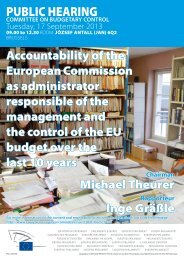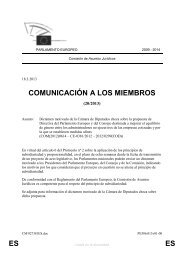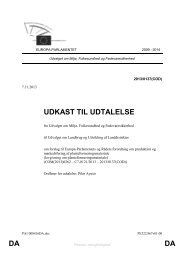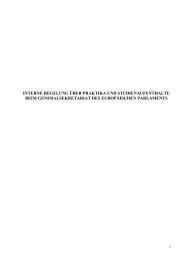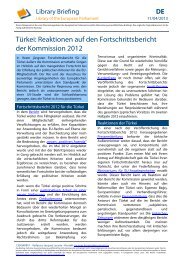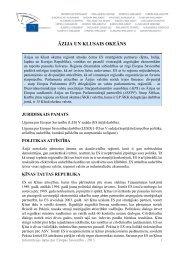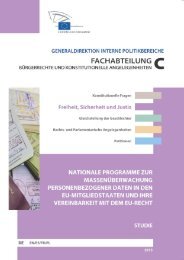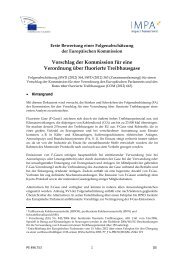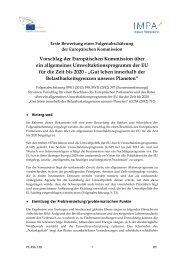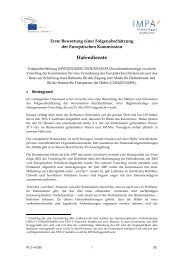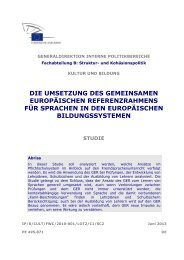Link to the study - European Parliament - Europa
Link to the study - European Parliament - Europa
Link to the study - European Parliament - Europa
You also want an ePaper? Increase the reach of your titles
YUMPU automatically turns print PDFs into web optimized ePapers that Google loves.
Policy Department D: Budgetary Affairs<br />
____________________________________________________________________________________________<br />
Enclose <strong>the</strong>m for a certain time period (e.g. <strong>the</strong> complete primary circuit in <strong>the</strong> existing and<br />
modified concrete structure, <strong>the</strong> reac<strong>to</strong>r vessel or o<strong>the</strong>r large equipment in a specially designed<br />
and built enclosure);<br />
Ensure that no one can enter <strong>the</strong> structure and no activated material or contamination can leave<br />
<strong>the</strong> structure;<br />
Leave this structure for a certain time period;<br />
Foresee a final step, in which <strong>the</strong> remaining materials are removed from <strong>the</strong> structure and ei<strong>the</strong>r<br />
released from regula<strong>to</strong>ry control (if decayed <strong>to</strong> below <strong>the</strong> prescribed concentrations), or are cut,<br />
conditioned and sent <strong>to</strong> <strong>the</strong> final disposal facility.<br />
The aims pursued by including such a step in <strong>the</strong> scheme can be manifold, as are <strong>the</strong> associated risks:<br />
Short-lived radionuclides decay during this period so that radiation fields (esp. gamma radiation)<br />
during <strong>the</strong> final step are less relevant. This concerns exclusively short-lived nuclides such as<br />
Cobalt-60, i.e. in activated steel structures. O<strong>the</strong>r parts, mainly of <strong>the</strong> contaminated primary<br />
cooling system, are contaminated with fission products (notably Cesium-137) and for <strong>the</strong>se parts<br />
decontamination has <strong>to</strong> be applied. Thus, such an aim only make sense in cases where <strong>the</strong><br />
material can be finally released from regula<strong>to</strong>ry control or when <strong>the</strong> final step(s) can be<br />
performed under considerably less complex conditions (e.g. without remote cutting) or where<br />
<strong>the</strong> decayed material becomes suitable for 'less reliably isolating' final disposal facilities). There<br />
are several risks and obstacles that can turn this aim <strong>to</strong> its opposite (e.g. materials with low<br />
concentrations of nuclides with adverse measuring properties increase necessary measuring<br />
efforts and expenses <strong>to</strong> be made, no nuclear shops able and willing <strong>to</strong> perform <strong>the</strong> final tasks are<br />
available any more, nei<strong>the</strong>r experienced personnel nor regula<strong>to</strong>ry means are available any more,<br />
<strong>the</strong> disposal facilities and <strong>the</strong>ir waste acceptance criteria have changed considerably, release<br />
criteria have changed <strong>to</strong> lower and more strict concentrations).<br />
The costs for <strong>the</strong> final steps have <strong>to</strong> be borne at a later time. This argument is shortsighted if <strong>the</strong><br />
previously named risks are considered. The <strong>to</strong>tal costs over <strong>the</strong> whole decommissioning scheme,<br />
with a long inactive enclosure period in between, can be considerably higher than those for<br />
immediate decommissioning (e.g. with extra cost fac<strong>to</strong>rs such as for re-building personnel,<br />
expertise and regula<strong>to</strong>ry administration from <strong>the</strong> very scratch, setting up specialized shops for<br />
performing <strong>the</strong> final steps, finding/building/operating/closing an extra disposal facility for <strong>the</strong><br />
<strong>the</strong>n-generated wastes).<br />
Similarly, <strong>the</strong> hope that money spent only years later might reduce overall costs is short-sighted:<br />
Only money that is explicitly set aside (as a reserve or fund) for that purpose can generate<br />
interests over time, assuming that interest rates remain high enough over <strong>the</strong> complete time<br />
period.<br />
Only if <strong>the</strong> inflation rate is continuously smaller than those interest rates, might a reduction of<br />
<strong>to</strong>tal costs be achieved.<br />
Increases in labor costs, one of <strong>the</strong> cost fac<strong>to</strong>rs in decommissioning, can outweigh much or all<br />
of <strong>the</strong> interest.<br />
42



